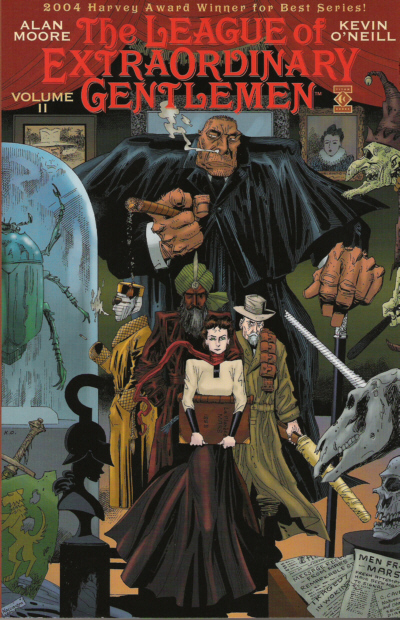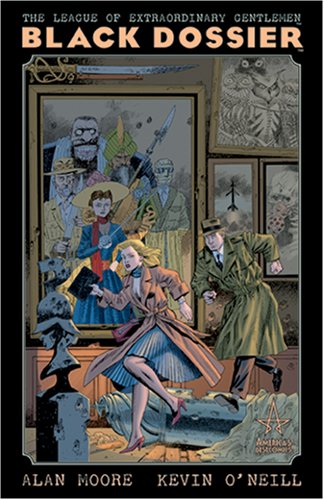It's The End, The End Of The Century: The League of Extraordinary Gentlemen Returns!
/
In the final weeks before the release of League of Extraordinary Gentlemen Volume III: Century Book One (whew!), I thought I’d look back at the previous LOEG books, ‘cause, you know…any excuse to read that stuff again. Contextually, though, it turns out it made a lot of sense, as the series keeps changing and evolving, so a look at its development might provide proper context for where it is now/where it’s heading. So, this time around, I’m going to examine what’s come before, and then have a look at what’s going on now, with LOEG Vol. III (which is actually the fourth LOEG project, but more on that in a bit).

Alan Moore and Kevin O’Neill kicked off this series in 1999 (ten years ago? Seriously? Jeez!) under the DC/Wildstorm imprint America’s Best Comics, a Moore-created label that he would eventually abandon because of his, shall we say, fractious relationship with parent publisher DC. The initial six-issue miniseries was a fairly high-concept adventure tale that introduced Moore and O’Neill’s Victorian-era covert military unit, comprised of famous literary heroes like Mina Murray (heroine of Bram Stoker’s Dracula), Allan Quartermain (star of H. Rider Haggard’s King Solomon’s Mines), Captain Nemo, Dr. Jekyll/Mr. Hyde, and the Invisible Man. The first LOEG series is a pretty straightforward three-act adventure—the team is assembled, they go on a mission to thwart Fu Manchu, and they eventually regroup to take down their true nemesis, Professor James Moriarty (who is also their employer, the mysterious spymaster “M”). The inaugural volume quickly establishes that the League’s adventures take place in an alternate universe where all fantastical fiction of the era resides side-by-side—look for allusions to Edgar Allan Poe, Charles Dickens, Edgar Rice Burroughs, H.P. Lovecraft, and literally hundreds of other authors and their works. To truly appreciate the scope of what Moore and O’Neill have done, be sure to check out Jess Nevins’ remarkable annotations of all the LOEG books (or buy the old-fashioned book versions of same, available now from Monkeybrain Press).

LOEG Vol. II picks up almost immediately after the conclusion of the first miniseries, although it’s constructed very differently—the framework of its plot is built around an existing narrative, namely H.G. Wells’ War of the Worlds. When the Martian tripods launch their assault, the League is there behind the scenes, participating in the campaign against the invaders and inevitably helping to destroy them (although the League as we know it is pretty much undone in the process). Moore and O’Neill are careful not to interfere with the events in Wells’ novel, but they do find all sorts of cool ways to integrate those events into the League’s larger fictional world. New characters, like Wells’ Dr. Moreau, are introduced, and not all the heroes from the first series survive.

With the third book, Black Dossier, the original intent was for Moore and O’Neill to create a sort of sourcebook for the fictional universe the League inhabits, but the creators got a bit more ambitious; the Dossier of the book’s title forms the basis of the sourcebook, detailing several centuries of the League’s different incarnations and adventures. However, this is contained within a framing sequence set in the 1950s, where the two surviving heroes of the first series steal the Dossier from British Intelligence, and are relentlessly pursued by James Bond, Emma Peel, and Bulldog Drummond. The Dossier excerpts are mostly told in prose, and include an unfinished Shakespeare play, a P.G. Wodehouse-style short story where Jeeves and Wooster meet Cthulhu, a Kerouac pastiche, and a Tijuana Bible inspired by Orwell’s 1984. There’s even a 3D section at the end (glasses included!), and a flexi-disc original song recording was planned but was abandoned during a long and ugly fight with parent company DC. The Black Dossier tried the patience of a lot of fans with its extended prose sequences, but if you can make time for them, it’s worth it. Among some of the fascinating details Moore and O’Neill reveal about their universe: Prospero, hero of The Tempest, was the first agent of the Crown to be codenamed 007, Dean Moriarty of On The Road was a distant relative of Professor Moriarty, and the England of the LOEG world went to war in 1939 not with Adolf Hitler but Adenoid Hynkel, Charlie Chaplin’s character in The Little Dictator. Granted, it would definitely have been cool to see the League take on their German and French counterparts, but we’ll have to settle for the abridged recaps in the chapter titled The Sincerest Form of Flattery.

Which brings us, finally, to the latest LOEG adventure, Century. The first of three 80-page volumes—stand-alone adventures that comprise a larger story spanning 100 years—Book One takes place in 1910. The current incarnation of the League, which includes a now-immortal Mina Murray and Allan Quatermain, gentleman thief A.J. Raffles, and gender-bending, ageless adventurer Orlando, acts upon the ominous visions of their psychic teammate Thomas Carnacki, who has seen that a sect of mystics may have engineered events to bring about the end of the world. Also, a plague of Jack the Ripper-style slayings besets the East End of London, and the rebellious daughter of former League member Captain Nemo finally inherits her position as the Captain of the dreaded Nautilus.
This newest LOEG series runs the risk of alienating readers drawn to the initial high-concept of the earlier books, as the cast of characters grows increasingly obscure. That shouldn’t be seen as a deterrent, however; Century has plenty of humour, violence, and portents of a dark future to satisfy fans. The apocalyptic plot conceived by the Crowley-like mystic Oliver Haddo and his sect probably won’t truly bear fruit until the end of the series, which will take place in the present day, making that portion of the story a bit unsatisfying (for now, anyway). In the meantime, though, Moore’s depiction of his heroes bickering like the world’s weirdest dysfunctional family is hilarious, and his gift for using song in his narrative, used to great effect in V For Vendetta and Top Ten, is on full display here—much of Book One’s plot is told in the form of Threepenny Opera, incorporating lyrics and characters from Mack the Knife and Jenny Diver. Kevin O’Neill’s artwork here is the tightest it’s been in a while, packed with obscure detail (is that the fertility idol from Raiders of the Lost Ark in one panel?) and terrific character detail. The dockside siege of London by the Nautilus’ pirate crew is particularly exciting, and pretty gory to boot. The text piece at the end, which ties together several fictional narratives and characters involving the moon, has lots of surprise cameos as well, like Stardust the Super-Wizard (last seen in Fantagraphics’ amazing collection of Fletcher Hanks comics, I Shall Destroy All The Civilized Planets!). New publisher Top Shelf has put together an appealing square-bound format for this book, and I can’t wait to see what the always-reliable publisher has planned for the inevitable collected edition. The new, extended format of this series will hopefully tide people over in the wait between volumes, but as long as Century doesn’t take 100 years to finish, I’ll be happy to wait.




